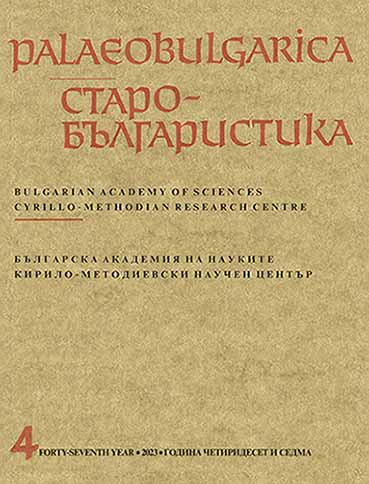Неизследвани страни от почитта към светите мъченици Ина, Пина и Рима във византийските и славянските агиографски и химнографски извори
Unexplored Aspects of the Veneration of the Holy Martyrs Innas, Pinnas and Rimmas in the Byzantine and Slavonic Hagiographic and Hymnographic Sources
Author(s): Maria YovchevaSubject(s): Language studies, Language and Literature Studies
Published by: Кирило-Методиевски научен център при Българска академия на науките
Keywords: Holy Martyrs Innas, Pinnas and Rimmas; Byzantine and Slavonic Hagiography; Byzantine and Slavonic Hymnography; Manuscript Menaiа.
Summary/Abstract: The article explores the controversial matters of the localization and chronologization of the martyr acts of the Scythian / Gothic? saints Innas, Pinnas and Rimmas, presenting data from the scant Byzantine and Slavonic hagiographic sources and the new archaeological findings from the Medieval city Zaldapa of Scythia Minor. Special attention is paid to the hymnographic office on the three martyrs, written in the 9th century by Joseph the Hymnographer, which is known from Byzantine manuscripts. The study focuses on the Slavonic translation of this office, attested in two related Eastern Bulgarian Menaia: Second Menaion of Dobrian (Оdessa National Scientific Library, Grig. No. 1/5) from the 13th century and Cod. 609 of Monastery Hilandar from the 14th century. The two key specificities of the translation are outlined in the study: 1) its non-homogenous nature, resulting from the interweaving of innovative and markedly archaic trends; 2) the abundance of inaccurately translated Greek words or phrases, or mistakes due to inaccurate understanding of the Greek original, paronymic errors or translator’s factual ignorance. The collation between the two Bulgarian copies evidences the closed tradition of this hymnographic text in Slavonic milieu, a text, which – once translated – has never been compared to the Greek original. At the same time, the composition of the office from the Monastery Hilandar manuscript was updated and supplemented, according to the rules of the Jerusalem Typicon, introduced to the South Slavonic context in the 14th century. The publication of the hymnographic text is based on the Cod. 609 from the Monastery Hilandar with versions from the Second Menaion of Dobrian.
Journal: PALAEOBULGARICA / СТАРОБЪЛГАРИСТИКА
- Issue Year: 2023
- Issue No: 4
- Page Range: 11-38
- Page Count: 28
- Language: Bulgarian
- Content File-PDF

